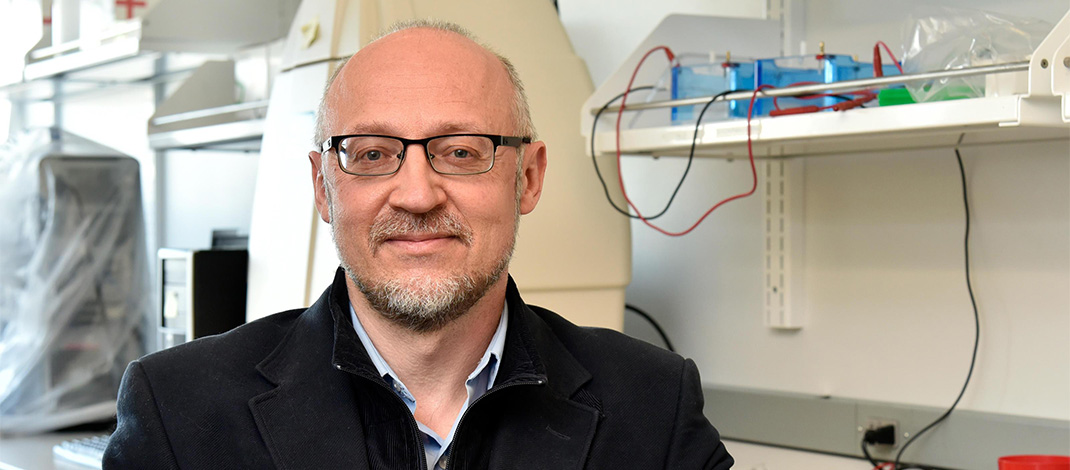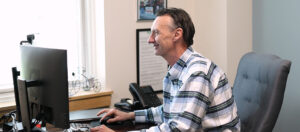By Steve Yablonski
He recently set up shop at the Business Expansion Center in Oswego. His client list already includes University of Denver, Colorado State, Harvard and others
Showing me around his new lab and explaining the function of all the high-tech equipment, Kestas Bendinskas was as happy as a seagull with a French fry.
Bendinskas, a distinguished service professor of SUNY Oswego’s chemistry faculty, has added another title to his list: entrepreneur.
Recently, he started Stress Bionalytics, LLC. He hopes to have the company fully staffed and operational by Aug. 1.
The facility, located alongside our offices in the Oswego County Business Expansion Center, 185 E. Seneca St., Oswego, will provide research and development services to private and academic clients predominantly in the sphere of measuring stress biomolecules in “difficult” matrixes, such as hair or nails, he explained.
“I got the keys from the Business Expansion Center on June 16 and I’ve moved in all the equipment that I’ve been accumulating in my garage into this newly painted lab since,” he said with a wave of his hand indicating the equipment precisely arranged on tables around the walls.
“We’ll be able to start working here [later this month],” he said in early July. “I am very thankful to Oswego County for being such supportive hosts of this new venture.”
He added that he is excited and “a bit scared” of this new step in his personal development journey.
“I’m 100% sure that it is a win-win-win-win for Oswego County — Oswego students’ success, SUNY Oswego’s chemistry department and all of my clients. I’m also sure that the Oswego County Business Expansion Center is happy to get a new and unique tenant,” he said.
“Our primary target is cortisol. It increases dramatically in concentration when one experiences short-term or chronic stress,” he said. “The immediate response can be assessed by measuring in saliva, long-term in hair.”
What is cortisol?
Cortisol, the primary stress hormone, increases sugars (glucose) in the bloodstream, enhances your brain’s use of glucose and increases the availability of substances that repair tissues. Cortisol also curbs functions that would be nonessential or harmful in a fight-or-flight situation.
Think of cortisol as nature’s built-in alarm system. It’s your body’s main stress hormone; working with certain parts of your brain to control your mood, motivation and fear.
Your adrenal glands — triangle-shaped organs at the top of your kidneys — make cortisol.
And how is it measured?
“We extract it from milled hair and measure using a well-known antibody-based technique called ELISA,” he said. “It takes three days. The extraction procedure takes three days because we have to extract it twice — overnight. But we can process up to 40 samples per day and also stagger samples; our current capacity is about 6,000 samples annually (with one manager and three interns).”
The data is used by medical, sport and psychology specialists who often prefer getting a physiological measure of stress, instead of an opinion about one’s stress, he said.
“That’s where we come in,” Bendinskas said. “A lot of universities, some doctors and even private companies are interested in our services.”
He already has an impressive client list: University of Denver, a veterinarian from Long Island, Colorado State, a doctor from Puerto Rico, Harvard and others.
Taking the next step
“I see this as the next step in my personal development,” he said. “It’s challenging to bring one’s knowledge to become a business venture, especially in the highly-competitive biotech field.”
His goal is to establish the company.
“It will be run by the manager, a SUNY-Oswego alumnus,” he said. “I plan to have three interns in 2022; they will get a feel for the industry, the internship credit and salary. The students will be able to put something of value on their resume.”
Is Bendinskas ready to quit his day job?
“I’m not quitting my day job just yet — I love every minute of it!” he said with a smile.
He was appointed to the faculty in 2003. When he first arrived at SUNY Oswego, “there were snowbanks four yards tall,” he recalled.
“That was during the winter when everything froze; we had icicles everywhere,” he added.




